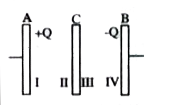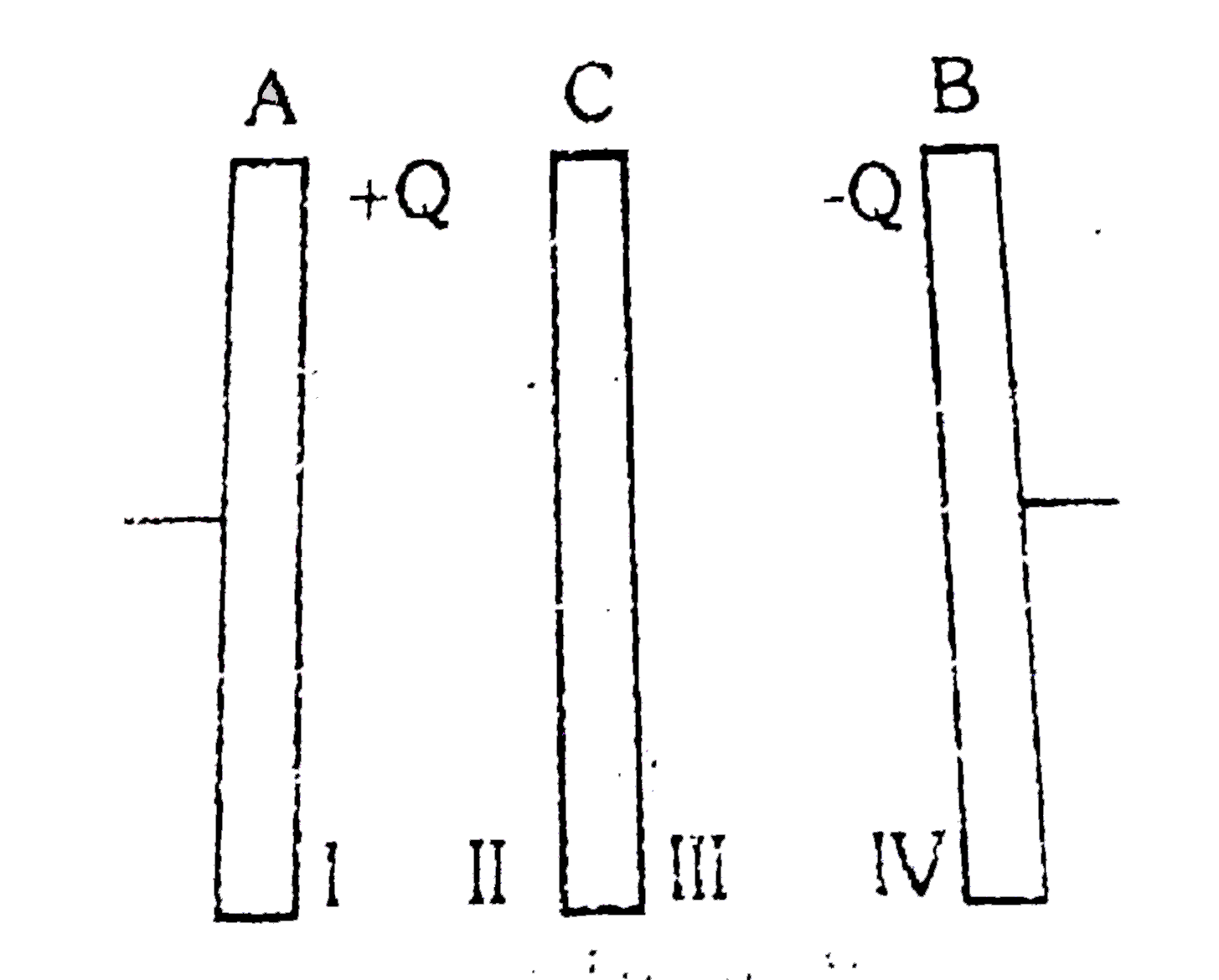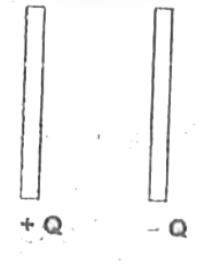Plates A and B constitute an isolated charged parallel plate capacitor. The inner surface (I and IV) of A and B have charges +Q and −Q respectively. A third plate C with charge +Q is now introduced midway between A and B which of the following statements is not correct ?

The surface I and II will have equal and opposite charges.
The surfaces III and IV will have euqal and opposite charges.
The charge on surface III will be greater than Q.
The potential difference between A and C will be equal to the potential difference between C and B.
The correct Answer is:D
Topper's Solved these Questions
- ELECTROSTATICSBOOK - AAKASH SERIESCHAPTER - ELECTROSTATICSEXERCISE - PRACTICE SHEET (EXERCISE -III ELECTRO FLUX & GAUSS.S LAW) (LEVEL - I (ADVANCED) MORE THAN ONE CORRECT ANWER TYPE QUESTIONS
5 Videos
- ELECTROSTATICSBOOK - AAKASH SERIESCHAPTER - ELECTROSTATICSEXERCISE - PRACTICE SHEET (EXERCISE -III ELECTRO FLUX & GAUSS.S LAW) (LEVEL - I (ADVANCED) LINKED COMPREHENSION TYPE QUESTIONS)
3 Videos
- ELECTROSTATICSBOOK - AAKASH SERIESCHAPTER - ELECTROSTATICSEXERCISE - PRACTICE SHEET (EXERCISE -III ELECTRO FLUX & GAUSS.S LAW) (LEVEL - I (MAIN) STRAIGHT OBJECTIVE TYPE QUESTIONS)
9 Videos
- ELECTROMAGNETICSBOOK - AAKASH SERIESCHAPTER - ELECTROMAGNETICSEXERCISE - ADDITIONAL EXERCISE
6 Videos
- ELEMENTS OF VECTORSBOOK - AAKASH SERIESCHAPTER - ELEMENTS OF VECTORSEXERCISE - QUESTIONS FOR DESCRIPTIVE ANSWERS
9 Videos
Similar Questions
Plates A and B constitutes an isolated, charge parallel plate capacitor. The inner surface (I and IV) of A and B have charge +Q and -Q respectively. A third plate C with charge +Q is now introduced midways between A and B. Which of the following statement is not correct?

View SolutionA parallel-plate capacitor is connected to a cell. Its positive plate A and its negative plate B have charges +Q and −Q respectively. A third plate C, identical to A and B, with charge +Q, is now introduced midway between A and B, parallel to them. Which of the following are correct?
View Solution
Knowledge Check
Plates a and B constitutes an isolated, charge parallel plate capacitor. The inner surface (I and IV) of A and B have charge +Q and -Q respectively. A third plate C with charge +Q is now introduced midways between A and B. Which of the following statement is not correct?
 AThe surface I and II will have equal and opposite chargesBThe surfaces III and IV will have equal and opposite chargesCThe charge on surface III will be greater than QDThe potential difference between A and C will be equal to the potential difference between C and B
AThe surface I and II will have equal and opposite chargesBThe surfaces III and IV will have equal and opposite chargesCThe charge on surface III will be greater than QDThe potential difference between A and C will be equal to the potential difference between C and BA parallel-plate capacitor is connected to a cell. Its positive plate A and its negative plate B have charges +Q and −Q respectively. A third plate C, identical to A and B, with charge +Q, is now introduced midway between A and B, parallel to them. Which of the following are correct?
AThe charge on the inner face of B is now −3Q2BThere is no change in the potential difference between A and B.CThe potential difference between A and C is one-third of the potential difference between B and C.DThe charge on the inner face of A is now Q/2.In an isolated parallel plate capacitor of capacitance C, the plates have charge Q1 and Q2. The potential difference between the plates is
AQ1+Q22CBQ1−Q22CCQ12CD−Q22C
Consider a parallel plate capacitor having charge Q. Then,

View SolutionTwo large conducting plates of a parallel plate capacitor are given charges Q and 3Q respectively. If the electric field in the region between the plates is E0 , then the force of interaction between the plates is

View SolutionTwo large conducting plates of a parallel plate capacitor are given charges Q and 3Q respectively. If the electric field in the region between the plates is E0 , then the force of interaction between the plates is

View SolutionA parallel plate capacitor C has a charge Q. The actual charges on its plates are
View SolutionA positive charge q is given to each plate of a parallel plate air capacitor having plate area A and plate separation d, then
View Solution
